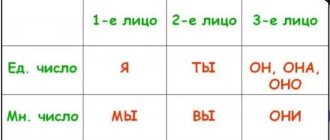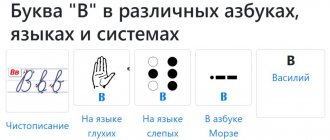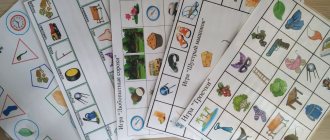Learning to read is directly related to learning to divide words into syllables. It is sometimes difficult for children to learn these rules, especially since the rules for dividing words into syllables and for hyphenation are significantly different.
While the baby is starting to read, but has not yet tried to write, you can tell him how to divide words into syllables without taking into account the rules of transfer. To do this, parents themselves need to remember several basic principles on how to break any word into syllables. You can download cards with syllables for free here.
The principle of dividing words into syllables
If you remember the curriculum in primary school, then a rule will arise in your memory: the number of vowels in a word, the number of syllables .
Therefore, to visually determine the number of syllables, you need to count the vowels. What letters do we classify as vowels? There are 10 vowel letters in the alphabet:
- A, O, U, Y, I, E - indicate one sound;
- E, E, YU, I – indicate two sounds (E=Y+E; E=Y+O; Y=Y+U; I=Y+A).
Let’s take the word “dangerous” as an example and divide it into syllables:
Dangerous=o-pass-no-e (4 syllables).
In this case, we simply divided the word into syllables based on the number of vowels. However, if the same word needed to be moved from one line to another, the division principle would be different (you cannot move one letter to another line):
Dangerous=dangerous – division of a word for hyphenation.
So, in order to correctly determine the number of syllables, the child needs to learn vowels.
Monosyllabic words
Based on the minimum number of vowels in a word, we select monosyllabic words that contain one phonetic syllable. Let's remember what a phonetic syllable is.
A phonetic syllable is one vowel sound or a vowel combined with one or more consonant sounds, which in the process of speaking are pronounced with one impulse of exhaled air.
Place your palm under your chin and clearly pronounce the words:
manhole, march, elk, bridge, leaf, moment, cheese, test, look.
On vowels, the chin will hit the palm once. This means that these words are monosyllabic.
Let's learn in more detail about the composition of monosyllabic words with one, two, three, four consonants.
Types of syllables
Knowledge about the types of syllables will greatly help in applying this rule. The types of syllables are distinguished by the final letter: vowel or consonant.
- An open syllable ends with a vowel.
- Closed ends with a consonant.
What are the types of syllables?
The open syllable is typically used for normal syllable division in reading. The syllable ends with a vowel, and the consonants behind it go to the next syllable:
Cone = shi-shka
Ice cream = mo-ro-je-no-e
Student = u-che-ni-tsa
Closed when dividing this word will be used to wrap to another line:
Dangerous=dangerous
Bump=bump
Install = install
A word can consist of one closed syllable: sleep, moss, sit down, etc.
Also, a closed one can be present when dividing a word into syllables when reading, if it ends with an unpaired voiced consonant in the middle of the word (sonorant): Y, R, L, M, N.
For example, MIKE = MAY-KA
SANKA=SAN-KA
Syllable types help to clearly distinguish the rules for dividing a word into syllables for reading and transferring.
How can you play and learn syllables at the same time?
Three syllable words
A word can have more vowels than two. Three vowel sounds combined with consonants form three-syllable words. When pronouncing a three-syllable word, three impulses of air occur, but one of them is stronger, which is created by the stressed vowel, and two are weaker in unstressed syllables. Let's make sure of this by saying the words:
l e -tchi-tsa, k-r about -va , white-li-zn a .
Examples of three-syllable words
In three-syllable words, consonants are grouped with vowels with two, three or even four sounds per syllable, for example:
- do-ro-ga, bo-ro-da, so-ro-ka;
- pri-sta-vka, kra-so-ta, te-le-fon, ka-ran-dash, bu-ma-zhka;
- jump up, shake up, jump up, wait, look.
A vowel can form an independent syllable in a three-syllable word:
- a-ktri-sa, a-zbu-ka, a-na-us, a-ra-his;
- o-city, o-val-ny, o-fresh-to-live, o-tli-chnik;
- u-gol-nik, u-ra-gan, u-chi-tel, u-slit.
Please note that the orthographic transfer of the words given above does not coincide with their syllable division due to the presence of a single vowel in their sound composition.
Let's learn the rule of word hyphenation in Russian.
Let's compare phonetic syllable division and orthographic hyphenation of words:
- u-gorge-e - gorge; a-zbu-ka - az-bu-ka;
- o-go-rod - o-go-rod; u-ra-gan - hurray-gan;
- o-tli-chnik - from-person-nick; a-dre-sat - ad-re-sat.
Games with syllables
Learning to read can be made fun and colorful by using various games with syllables.
Find out the syllable type.
In this game, you can ask children to find an open and closed syllable from those proposed. The game is good for children who are preparing for school, can read and imagine what an open and/or closed syllable is.
For example, in the word “dangerous” (o-pas-no-e) there are 3 open and 1 closed syllables.
Find the syllable in the word.
Define some simple syllable for the games, for example, “KO”. Arrange a competition with your child to see who can name the most words with this syllable.
For example, CAT, COW, COM, GOAT, etc.
This way you will teach your child to visually identify the letter composition of a word.
Which word has three syllables.
This game involves the ability to divide words into syllables for reading and count their number. Ask your child to name which word has three syllables, which has five, etc. To do this, the baby will have to work hard to divide words into syllables in order to find out how many syllables are in a word.
For example, the word “go-ro-shi-na” has 4 syllables, and the word “mo-ro-zhe-no-e” has 5 syllables.
Let's play word creation.
Creating new words is also fun. Try to take several syllables from different words and independently come up with a new word from them (make sure that the child does not invent non-existent words, but relies on meanings or vocabulary that already exist in the language). Ask to name the types of syllables in a word.
Which of the proposed syllables comes first in the words.
For this game, take several three- or four-syllable words (for example, cat, dog, dangerous, orange). You can use pictures to indicate them if the child still doesn’t read well. Write out the syllables randomly. Then ask your child to name the words presented in the pictures and name the first syllables in them.
Which letter goes where.
This game is based on a technique proposed by speech therapist Nadezhda Zhukova and presented in her textbook for children “A Primer”. If you do not have this book, you can master this technique yourself.
Its meaning is to clearly show the child the principle of reading using syllables as an example.
Take a syllable, divide it into letters and draw them on opposite ends of the sheet. From one letter to another, draw or glue a running man. Any toy that the baby will lead from one letter to another is suitable for this purpose. In this case, the sounds of the syllable are called, smoothly flowing into each other. Use an open syllable to play.
The second version of this game. Draw the initial letters of the syllable in capitals at some distance from each other. From them, roughly draw two lines in the form of a wedge and along them write several vowels from the syllable, gradually reducing them in size and then increasing them. Then ask your child to read what is written. He must extend the vowel sound in the syllable. Thus, the child learns that the base of a syllable is a vowel sound.
Syllabic coloring pages.
All children love to color. But the tasks here are unusual. The picture, like a puzzle, is drawn into separate parts, in which syllables of the same consonant are randomly written, for example: MA, MO, MU, WE, MI, ME, etc. Each syllable has its own color. If the child reads the syllables correctly and colors them, he will receive a color picture. This is how we teach the baby to independently find the necessary syllables.
There are a lot of similar games that can be offered. You can come up with them yourself in the process of teaching your child to read and divide words into syllables, memorizing the types of syllables. Remember that the main thing is to make reading interesting, then the books will later seem like a real magical world!
Sound superiority
Let's list the rules when there are more sounds than letters. Exercises in phonetic analysis of lexical units often cause difficulties for pupils and students. Words that have fewer letters and 1-2 more phonemes are often difficult to parse letters and sounds.
Note! A letter is a graphic unit, an icon used in writing. Sound is a phonetic unit that indicates the sound of a graphic icon when pronounced.
Such discrepancies arise if the letters “e”, “e”, “yu”, “ya” are present in the lexeme under study.
These vowels are special, they have their own trick, which lies in their special expression in speech: they do not have their own personal phoneme.
In the case when the listed vowels are in a position after a consonant, they soften it. And in addition to this, vowels are pronounced as their opposite: “e” like “e” or “i”, “e” like “o”, “yu” “u”, “ya” “a”.
For comparison: onion (the consonant “l” is hard, because after it there is a vowel “u”), hatch (“yu” softens the consonant “l” and turns into “u”).
This is interesting! Increasing literacy: how many vowel sounds are there in the Russian language?
In other cases, each of them breaks down into 2 phonemic units, one of which is “th”, the second is the pronunciation of the opposite vowel. Due to them, the number of sounds can be increased.
This happens in positions when:
- “cunning” vowels are at the beginning of the word (raccoon, fir tree, cabin boy, apple),
- come after vowels (fought, yours, edge, mine).
Important! Learning the rule is not difficult: it will take no more than 5 minutes, but it will help prevent mistakes in the future.
Word Analysis Example
For comparison, below are several analysis samples for which words with fewer letters and words with the same letter-sound number were taken:
- Lighthouse. There is “I” here, it is in the position after the vowel “a”, which means it breaks up into “y-a”. There are no other special cases. Let’s write the transcription as follows: “mayak”, according to it, the word consists of 5 sounds. This means it has 5 sounds and 4 letters, the number does not match.
- Snowstorm. There is “yu” here, its position - after “b” means it breaks up into “y-y”. There is also “b”, which is not pronounced at all. We will write the transcription as follows: “v’yuga” (“b”) 5 stars, 5 b. Since “b” was not included in the transcription, the quantity is equalized, despite the fact that “yu” disintegrated into “y-u”.
- Yula, only 3 letters. There is “yu” here, the position is the beginning, which means it breaks up into “y-y”. There are no other special cases. Let's write the transcription like this: “Yula” 4 sounds. The quantity did not match.
- Christmas tree decoration). There is “е” here, the position is the beginning, which means it breaks up into “y-o”. There is also “ya”, it is in the position after the vowel - which means it breaks up into “y-a”. There are no other special cases - most likely, there will be fewer graphic signs here than phonetic units. For approval, let’s write down the transcription: “Yolochnaya” 9 stars, 7 b.
Cabin: phonetic analysis of the word
We examined samples of phonetic analysis: 3 words with more sounds than letters (lighthouse, yula, fir-tree), one with the same meaning of units (blizzard). To complete the task correctly, attentiveness and knowledge of theoretical material are required.
Example words
There are quite a few lexemes in the Russian language in which there are more sounds than letters - this phenomenon is considered quite widespread.
Runs: phonetic analysis of the word
Let's look at a few examples:
- eralash – “yiralash”,
- apple - “yablaka” (also apple and the like),
- caustic – “yetk`iy”,
- raccoon – “yinot”,
- fir tree - “yolka” (fir tree is not suitable, because there is “b”, it equalizes the meaning),
- capacious - “yomk`iy” (capacity is not suitable, because there is “b”, it equalizes the value),
- lawyer – “yur`ist”,
- hawk – “yastr`ip”,
- young man - “yunasha” (youth is not suitable, because there is “b”, it equalizes the meaning),
- piano – “rial`”,
- despondency - “discouragement”,
- light – “sv’etlaya”,
- beautiful - “kras`ivaya”.
Examples can be supplemented with other feminine adjectives (happy, wise, beloved, stranger and others).
This is interesting! What is the difference - to wear or dress, how to write correctly
3 letters and 4 sounds
Below are words that also have an unequal number of sounds, compared to graphic signs:
- yama - "yama"
- yula – “yula”,
- comfort - “coziness”,
- food - "yida"
- neck – “sheya”,
- I sing - “payu”,
- ruff – “yorsh”,
- thuja – “thuja”.
Yula: phonetic analysis of the word
3 b. and 4 stars in a lexeme it can be if it contains vowels that break down into 2: e, e, yu, i. This occurs in cases where the indicated vowel is at the beginning, or it comes after another vowel.
5 sounds and 4 letters
In these examples, the number of phonetic and graphic signs is also not equal:
- lighthouse - "lighthouse"
- give – “dayut”,
- sings - “poyot”,
- snake – “snake”,
- washes – “washes”,
- yours - “svayo”,
- bright - "yarka"
- raccoon – “yinot”.
Hedgehog: phonetic analysis of the word
There are fewer graphic signs than sounds; for the same reasons, e, ё, yu, i break down into 2 meanings, because they are in the initial position or after a vowel.
This is interesting! Where is the correct accent in the word beet?
Determining the number of sounds
The presence or absence of “tricky” vowels will help you quickly determine which word has more phonemes than graphic icons.
To find out whether the elements being studied coincide in quantity, you need to perform a certain sequence of actions.
The algorithm is as follows. Write out the word being analyzed from the text and look carefully to see if it contains “e”, “e”, “yu”, “ya”.
If so, determine their position:
- after a consonant,
- after hard or soft signs,
- after a vowel,
- the very beginning.
This is interesting! We speak competently: is there a word no in Russian?
Continue analysis depending on position:
- If they come after a consonant, then most likely the number will match (unless there are other special cases of phonetics, as well as ъ/ь),
- When the listed vowels come after ъ/ь, the number will most likely coincide (these signs do not have a phoneme),
- The positions at the beginning of the word and after the vowel indicate that we have before us the situation under consideration with the formation of an additional phoneme.
- To confirm the correctness of your reasoning, you need to make sure that there are no other special cases of phonetics in the lexical unit under study.
The expression “special phonetic cases” refers to phenomena that influence the difference in the number of units under study.
Word phonetic analysis plan
These are the following cases:
- doubled and unpronounceable consonants,
- hard/soft signs,
- vowels “e”, “e”, “yu”, “ya”.
Important! If a word containing the vowel e, ё, yu or ya includes a soft or hard sign, there will be an equal number of phonemes and graphic signs (unless there are other special cases), because the hard and soft signs are not pronounced and do not have a phoneme.









